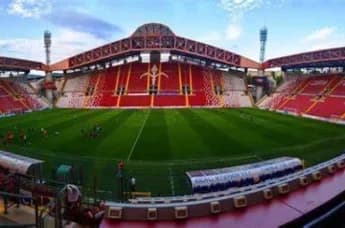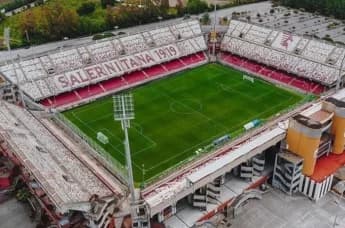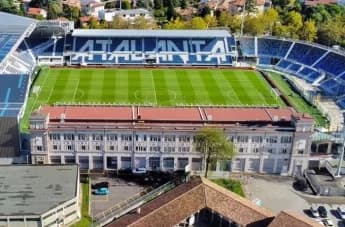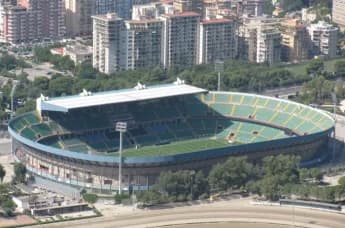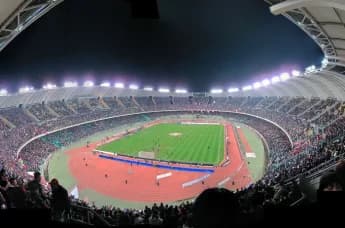The Stadio Olimpico stands as a symbol of Italy's rich sporting history, offering unforgettable experiences through legendary events and modern amenities amidst breathtaking Roman scenery.
The Stadio Olimpico, a magnificent symbol of Italian sports, proudly resides within the Foro Italico sports complex in Rome, Italy. Situated at the foot of Monte Mario in the lively Della Vittoria district, this famous stadium embodies Italy’s deep love for football, athletics, and various cultural events. Since it was inaugurated on May 17, 1953, during a match between Italy and Hungary, the stadium has evolved into one of the most esteemed venues in the world.
Originally built to hold an impressive 100,000 spectators, the Olimpico was designed to reflect the magnificence of Italian architecture and the nation’s increasing passion for sports. Throughout the years, the stadium has undergone numerous renovations, each one improving its structure and facilities while maintaining its historical character. With a current seating capacity of 74,000, it remains a vital center for Italy’s sports and cultural events.
The Stadio Olimpico serves as the home stadium for two of the most celebrated clubs in Serie A, AS Roma and SS Lazio. Their intense rivalry generates some of the most exciting atmospheres in global football. Additionally, it frequently hosts matches for the Italian national football team, enhancing its prestigious reputation. In addition to football, the stadium has played host to athletic events, concerts by internationally acclaimed artists, and grand ceremonies that bring together fans and spectators from all over the world.
Throughout its history, the venue has played a pivotal role in numerous significant events. It was instrumental during the 1960 Summer Olympics, hosting both the opening and closing ceremonies along with various athletic competitions. Additionally, the Stadio Olimpico was a prominent site for the 1990 FIFA World Cup, thereby establishing its reputation in the annals of sports history. Furthermore, it has been the chosen location for major European tournaments, such as the UEFA European Championships, numerous Champions League finals, and several editions of the Coppa Italia finals.
Set against the beautiful backdrop of the Foro Italico complex, attendees at the Stadio Olimpico enjoy more than just a sporting event or concert. The area is abundant with historical sites, vibrant greenery, and scenic pathways that provide stunning vistas of the city. Its prime location ensures convenient access while offering a rich cultural experience immersed in the lively atmosphere of Rome.
As one of the most iconic stadiums in the world, the Stadio Olimpico transcends its role as a sports venue; it stands as a testament to resilience, tradition, and the profound love a nation has for sports and culture. It serves as a gathering place where history, passion, and contemporary spirit come together, forging unforgettable experiences for both athletes and supporters.
Memorable Matches
The Stadio Olimpico has hosted countless memorable matches that have profoundly influenced the history of football. One of the most significant events was its inaugural match in 1953, a captivating clash between Italy and Hungary that introduced this legendary venue to the world. During the 1960 Olympics, the stadium emerged as a central point of global attention, featuring the opening and closing ceremonies, as well as the athletics events, embodying the ideals of unity and athletic excellence.
In 1968, the stadium was the backdrop for Italy's memorable victory in the European Championship final against Yugoslavia. After a challenging first match that ended in a draw, Italy clinched the title in a replay with a 2-0 win, bringing honor to the host nation. Twelve years later, during Euro 1980, the Stadio Olimpico played host to three group matches and the final, where West Germany emerged victorious over Belgium with a score of 2-1, further solidifying its status as a leading football venue.
The stadium’s magnificence was prominently displayed during the 1990 FIFA World Cup, where it hosted all of Italy’s group stage matches and the subsequent knockout rounds, culminating in the final showdown between West Germany and Argentina. In a thrilling contest, West Germany secured the championship with a close 1-0 win, a match that has become a significant part of football history. Additionally, the Olimpico has been the venue for several European Cup and Champions League finals, including Liverpool’s triumph over Borussia Mönchengladbach in 1977 and the memorable 1984 final, which featured a dramatic penalty shootout between Liverpool and AS Roma.
In recent years, the 1996 Champions League final showcased Juventus as they triumphed over Ajax in a thrilling penalty shootout. Meanwhile, in 2009, Barcelona put on a spectacular display, besting Manchester United with a score of 2-0, further asserting their supremacy in European football. These memorable matches serve not only to emphasize the Stadio Olimpico's capacity for hosting high-pressure events but also to reinforce its status as a venue where dreams come to life and legends are forged.
Amenities & Services
The Stadio Olimpico exemplifies architectural excellence and contemporary sports facilities. Originally built to hold up to 100,000 attendees, the stadium has seen numerous significant renovations to uphold its reputation as one of the foremost sporting venues globally. After its initial establishment, substantial upgrades were made for the 1960 Olympics, reshaping the vast terraces into seating areas, which decreased its capacity to 53,000 while greatly enhancing the comfort and safety of spectators. Additional developments in preparation for the 1990 FIFA World Cup modernized the stadium further. The playing field was positioned closer to the audience, creating a more intimate atmosphere, and a cutting-edge roof was added, providing improved shelter for fans from the weather.
The stadium features top-notch amenities, including roomy seating areas that provide unobstructed views from all angles, VIP lounges that deliver premium hospitality services, and state-of-the-art media and broadcasting facilities designed for international coverage. Contemporary lighting systems perfectly illuminate the pitch for night events, while sophisticated sound systems enhance the vibrant atmosphere created by the fans.
The Stadio Olimpico features a wide range of facilities aimed at improving the experience for fans. Guests can savor a diverse selection of food and drinks available at various concession stands placed throughout the stadium, which helps to minimize waiting times during busy events. Additionally, the venue is designed to be fully accessible, offering accommodations for spectators with disabilities, such as specialized seating areas, elevators, and accessible pathways.
The area surrounding the venue features ample parking and a well-developed transport network, ensuring easy access to the stadium for both local residents and international visitors. The adjacent Foro Italico sports complex enhances the stadium's appeal by providing additional amenities like swimming pools, training facilities, and tennis courts, establishing it as a central hub for a variety of sports and recreational activities.
In recent times, renovations have emphasized sustainability and technological improvements, such as energy-efficient lighting and upgraded digital ticketing systems to facilitate smoother entry procedures. These developments ensure that the Stadio Olimpico not only maintains its historical allure but also adapts to the demands of contemporary sporting events, providing an exceptional experience for both athletes and fans.
Significance in History
The Stadio Olimpico possesses significant historical importance, serving not only as a representation of Italian sports culture but also as a site that has witnessed crucial events in international football and athletics. Built during Italy's Fascist period as part of the expansive Foro Italico sports complex, its inception embodies the connection between politics and sports during the early 20th century in Europe. Originally imagined as the Stadio dei Cipressi, it emerged as a prominent venue for major gatherings and competitions, symbolizing the regime's ideals of grandeur and unity through athleticism.
The Stadio Olimpico’s involvement in the 1960 Rome Olympics signified a pivotal moment, highlighting Italy’s revival in the post-war era on the international scene. By hosting the opening and closing ceremonies along with the athletics competitions, the stadium became the backdrop for memorable events, such as Wilma Rudolph's remarkable achievements, which epitomized overcoming challenges. This event also marked a significant milestone for the Stadio Olimpico, elevating it from a local sports venue to a globally recognized site.
The significance of the stadium was further amplified as it served as a central venue for prestigious football tournaments, including the UEFA European Championships in 1968 and 1980, the FIFA World Cup in 1990, and various European club finals. Noteworthy matches, such as the Euro 1968 final where Italy emerged victorious over Yugoslavia in a replay, and the 1990 World Cup final in which Germany triumphed over Argentina, solidified the stadium’s standing in the chronicles of football history.
The Stadio Olimpico has consistently been a cornerstone of Italian football, acting as the shared venue for both AS Roma and Lazio. It has witnessed numerous fervent derbies and memorable moments that highlight the intense rivalry existing between these two teams.
In addition to sporting events, the Stadio Olimpico has been the venue for concerts, cultural occasions, and ceremonies, establishing itself as a versatile location. Its ability to withstand years of renovations demonstrates its flexibility and lasting significance. By adopting technological upgrades and structural improvements, the stadium has maintained its historical essence while also functioning as a contemporary center for international events.
In current times, the Stadio Olimpico is more than just a sporting arena; it epitomizes Italy's cultural and historical journey, symbolizing the unity, fervor, and grandeur that characterize the nation's connection to sports.
Future Events
The Stadio Olimpico remains a central hub for premier sports and entertainment events, upholding its status as one of Europe’s most renowned venues. Upcoming, it will host a lineup of significant football matches, including Serie A games featuring AS Roma and Lazio, two of Italy’s most fervent clubs. Additionally, the stadium plays a crucial role in the Coppa Italia, with the finals frequently taking place beneath the illuminating lights of the Olimpico, heightening the tournament's excitement and prestige.
International football is a key feature of the Stadio Olimpico's schedule, as the venue regularly hosts matches for the Italian national team. With Italy gearing up for future UEFA European Championship qualifiers and international friendlies, fans can look forward to thrilling performances by the Azzurri in their pursuit of success. Furthermore, the stadium is under consideration for hosting prominent matches in upcoming international tournaments, reinforcing its significance in the world of football.
In addition to football, the Stadio Olimpico remains a popular venue for significant cultural events, hosting international music concerts featuring famous artists from around the world. Its impressive capacity, excellent acoustics, and historic atmosphere make it an ideal location for performers looking for a memorable stage in the Eternal City. Audiences can anticipate a variety of performances that unite diverse crowds beneath the Roman sky.
The Stadio Olimpico continues to serve as a key location for the annual Golden Gala, which is part of the Diamond League series in athletics. This prestigious event attracts the top track and field athletes from around the globe, who compete before an enthusiastic audience, honoring the rich Olympic heritage of the stadium.
With upcoming upgrades and modernization efforts in specific areas, the Stadio Olimpico is set to improve the overall fan experience while continuing to host a diverse array of events. Its capacity to merge traditional elements with contemporary advancements guarantees that it will remain a pivotal hub for sports and entertainment in Italy for many years ahead.
Experience for Fans
Experiencing an event at the Stadio Olimpico is truly memorable, presenting a captivating mix of history, enthusiasm, and contemporary facilities. Located in the renowned Foro Italico district of Rome, the stadium offers spectators stunning vistas of Monte Mario and an immersive feeling of being in a historically rich venue. Be it a football match, a concert, or a significant athletic competition, the ambiance at the Stadio Olimpico is vibrant and charged, powered by the passionate fans of AS Roma and Lazio, alongside enthusiastic supporters from around the world.
The approach to the stadium creates an inviting atmosphere, with easy access through public transport, plentiful parking spaces, and picturesque views surrounding the sports complex. Upon entering, fans are welcomed by roomy seating and a striking roof design that enhances sound quality and provides an unobstructed view of the field or stage from almost any position.
Throughout the venue, food and beverage stalls are thoughtfully placed, providing a variety of traditional Italian snacks and drinks, as well as international fare. The hospitality services include VIP lounges and premium seating areas designed for those who desire a more opulent experience. These areas feature exclusive dining options, comfortable seating, and convenient access to the events, ensuring a memorable outing.
The design of the stadium emphasizes inclusivity, featuring accommodations for disabled guests and families, which creates a welcoming atmosphere for everyone. Cutting-edge screens and audio systems enhance the live experience, ensuring that fans remain engaged and well-informed throughout the event. The recently renovated seating offers comfort even during lengthy occasions, while the energetic crowd contributes to the overall ambiance, making every event truly memorable.
The fervor for football in the region is unmatched, particularly during the Derby della Capitale, where AS Roma and SS Lazio compete against each other. The atmosphere is heightened by passionate chants, vibrant flags, and impressive tifos, creating a sensory experience that lingers well beyond the final whistle. Additionally, concerts and various cultural events take advantage of the stadium's prestigious backdrop, turning them into unforgettable occasions.
After leaving the stadium, visitors can venture into the Foro Italico complex, which features picturesque walking paths and notable landmarks that enrich their experience. The Stadio Olimpico offers more than just a sporting event or performance—it provides a deep cultural dive into the vibrant history of Rome's sports and entertainment scene.



